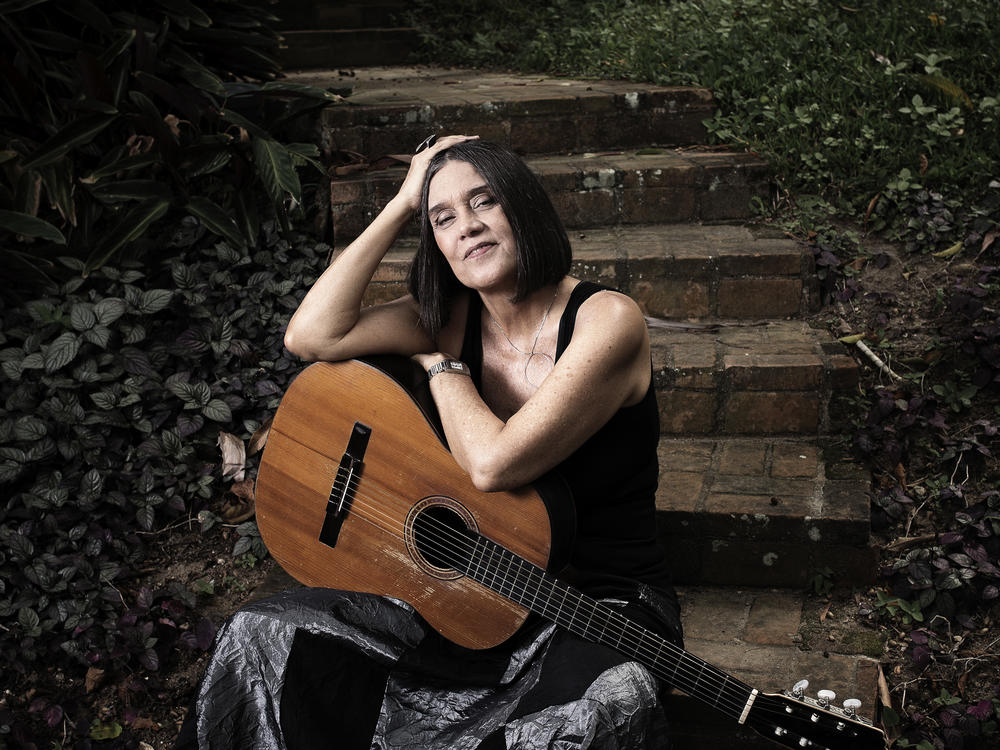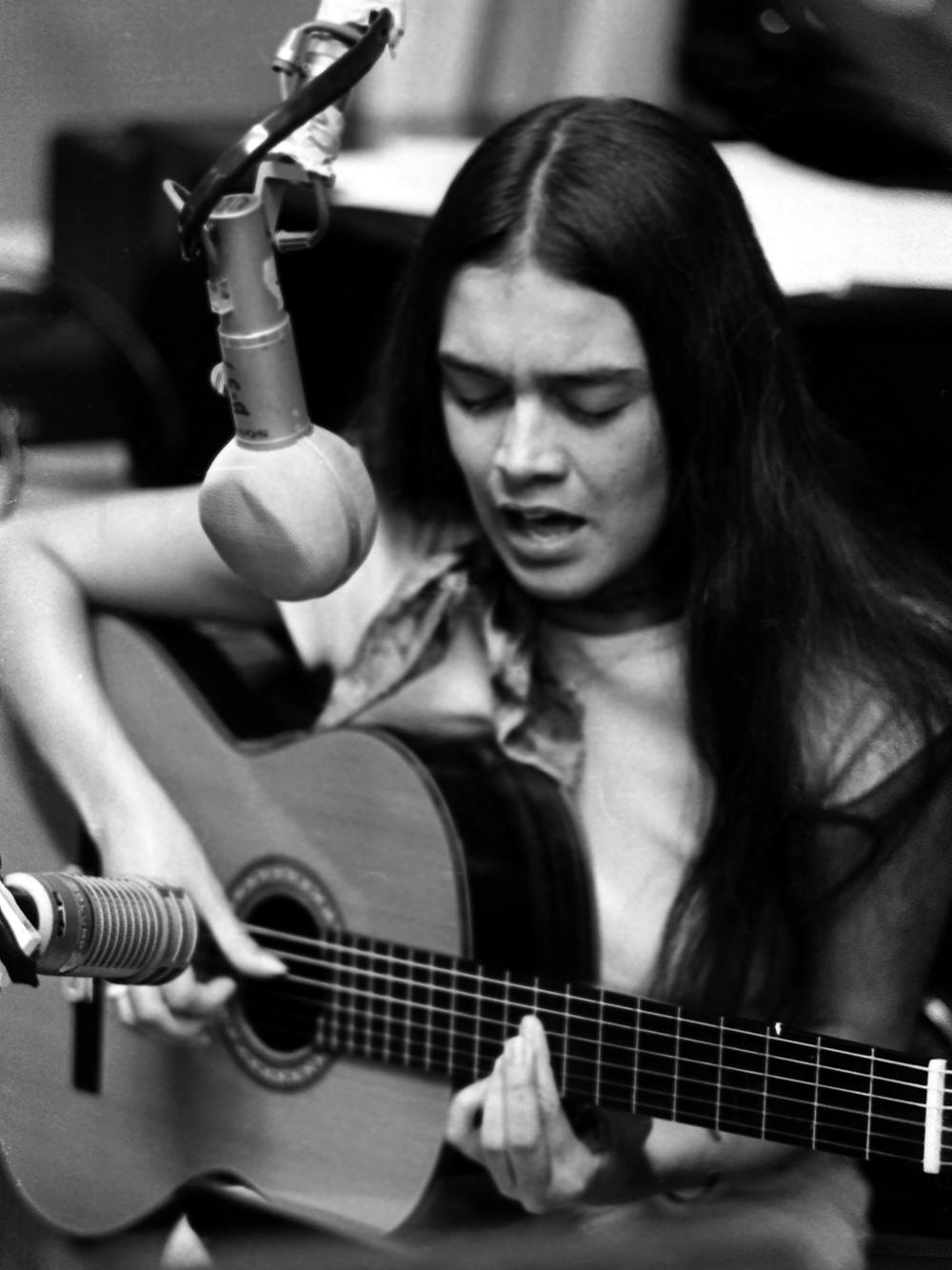Section Branding
Header Content
Unreleased for decades, Joyce Moreno's 'Natureza' is a snapshot of newfound freedom
Primary Content
At her home in Rio de Janeiro, the Brazilian singer-songwriter Joyce Moreno waxes philosophical about an album that sat unreleased for upwards of 45 years. "A vida tem sempre razão," she says over video chat, quoting fellow Brazilian poet Vinicius de Moraes (himself famous for writing the words to "Girl from Ipanema"), before translating the line: "'Life is always right.' Whatever happens, life has its reasons, it's always right."
We're discussing Natureza, an album Moreno recorded in New York City back in 1977 with legendary arranger and conductor Claus Ogerman and a crack ensemble featuring Brazilian session musicians and jazz players ranging from former Herbie Hancock bassist Buster Williams to session man Joe Farrell (whose silken sax and flute work could be heard accompanying the likes of Roberta Flack, Aretha Franklin and Laura Nyro at the time).
Joyce Moreno was in line to become — if not as familiar a name as the women above — then at least as established as fellow international Brazilian luminaries like João Gilberto, Astrud Gilberto, or Antonio Carlos Jobim, names well known in the U.S., thanks in no small part to Ogerman's arrangements for them. His charts narrowed the gaps between bossa nova, jazz, easy listening and pop and Moreno was an ideal fit, with her breezy delivery and skillful guitar. It seemed that with Natureza, Moreno's time had finally arrived.
But the Natureza recordings were unheard until now, with a release on the British imprint Far Out Recordings. For label boss Joe Davis, he believes that had her album been released back then, it would have found Moreno in the company of other jazz artists pushing towards mainstream success, like George Benson and Donald Byrd. "There was a real change in jazz record sales and appreciation at that particular time, so it would have been a perfect moment for Joyce's music to be heard," he says. "It would have been amazing for Joyce and her career obviously and would've been appreciated throughout the world by jazz and world music fans."
Natureza also could have been the album that catapulted Moreno to an international audience. "When you say 'could have been,' it's because it wasn't," she says with a small smile. "For me, it's history. It's a moment of my career, my life, all of us who participated. Of course, I knew eventually it would happen. Maybe not in my lifetime, but I knew it would happen at a certain point."
Fame instead came decades later for her outside of her native Brazil, thanks to the championing by European radio DJs like Gilles Peterson, Patrick Forge, and even Davis, whose label has released over six Joyce albums to date. By that point in her career, Moreno was already used to adversity. She picked up the guitar at the age of 14 and taught herself how to play, soon after writing her own songs. In 1967 her song "Me Disseram" became a finalist in the country's International Song Festival, but its first person perspective as a woman scandalized journalists and critics.
"It was considered immoral; it was not appropriate for a 19-year-old girl to write and sing things like that," she says. "It was ridiculous, of course. But you have to keep in mind: by 1967 at the Song Festival and 1968 on my first album, we were living under a right-wing dictatorship, a military government in a very conservative Catholic country." It was a level of repression that imprisoned — and then exiled — stars like Caetano Veloso and Gilberto Gil and suppressed the lyrics of others. Moreno says that censors came after her for having words like "pregnant" and "giving birth" in her songs.
Yet even in the face of such oppression, her star was ascendant, thanks to her self-titled 1968 debut and 1972's Nelson Angelo E Joyce (a classic of the era recorded with her then-husband), showcasing Joyce's dulcet voice and nimble guitar work. "Joyce is a really unique Brazilian singer-songwriter and she's an insane nylon guitar player," enthuses modern tropicalia-indie musician Tim Bernardes, whose trio O Terno and his own solo work draws on the lineage that Moreno's music embodied, citing her appearance on Milton Nascimento's album Clube da Esquina 2 as an influence. "I was blown away when I first [heard] her guitar playing on that recording, the voicings on the chords, that song's melody and harmony — so beautiful."
In 1977, Moreno was hired for a residency at New York's Cachaça, a very fancy and expensive club offering up Brazilian music for its upscale Upper East Side clientele. "At first, I wasn't crazy about the city because I was staying at a fancy apartment owned by the owner of the club. It was a rich area, I thought it was a bit boring," she recalls. But she soon fell in with the Brazilian expat music community there, who jammed with other jazz musicians nightly. Meanwhile, she continued to work uptown in a duo with another singer and guitarist, Mauricio Maestro. In that expat circle, Moreno met her future husband, percussionist Tutty Moreno, moving in with him in his West Village apartment and finding herself in the center of a vibrant musical scene: "Then I really started to love the city, being involved in a different environment."
It was another in-demand Brazilian percussionist, João Palma, who connected Moreno with the famous German arranger, conductor, composer and pianist Claus Ogerman, who was operating at a peak by the late '70s, with credits ranging from Bill Evans and Barbra Streisand to Benson. Moreno and Maestro auditioned for Ogerman and decided he wanted to produce an album with them.
The seven songs comprising Natureza were then laid down over the course of a few days. And while they bear the broader timbral palette of the Grammy-winning arranger, it never overshadows the songs themselves. It both offers a glimpse at a more lush version of Moreno's music while keeping the rhythmic suppleness of her dynamic with Maestro intact. "Claus was super respectful; he never tried to change whatever we were doing or give different ideas," Moreno recalls. "He let the music run free." Nowhere is that freedom more evident than on "Feminina." Most fans will no doubt be familiar with the tidy, buoyant 3:48 version re-recorded by Moreno in 1980 for her album of the same name, as it remains one of her most beloved songs. The lyrics are a dialogue between mother and daughter, as the younger one asks what it means to be "feminine," the mother explaining that, as Moreno explains to a non-Portuguese speaker, "it's not your looks, it's something inside."
But the original version of "Feminina" — as captured by Ogerman in 1977 — clocks in at a whopping 11:25, running as fast and free as a wild stallion across a field. "I had just written the song and we didn't know how to finish it," Moreno says. "So we just played and played and went on playing. At the end, Claus said, 'This is too exciting, I'm not going to touch that or put an orchestra on top of that.' And indeed, that is what he didn't do." It's a delirious, joyous moment, captured live in the studio by a nine-piece band plus a five-piece wind ensemble, propelled along by a tight Brazilian percussion trio, with plenty of space for a vibraphone solo, a flute solo (courtesy of Joe Farrell), and Moreno and Maestro's voices darting around one another in increasingly thrilling runs. Elsewhere, Ogerman used the deft weaving guitar interplay between Moreno and Maestro as the basis for his charts, elevating songs like the Maestro-sung "Coração Sonhador," the haunting duet "Ciclo Da Vida," and the exquisite "Descompassadamente" to even dreamier highs.
But after the initial sessions, things started to go awry. Moreno's daughter fell ill and she returned to Rio to care for her. She corresponded with Ogerman by letter as he attempted to sell the album to interested labels and finance the opulent orchestration he envisioned for it. A deal was done with Horizon Records, but soon the label went bankrupt. "Claus wanted me to come back and re-record the vocals in English," she says. "At the time, I couldn't do that. I was here, pregnant with my third child and I couldn't leave the country." At some point, ownership reverted back to Ogerman, but when Moreno's record labels inquired about releasing the music in the 1990s, his asking price to finish it was steep, still asking for peak-1970s fees. In the end, Ogerman was only able to mix "Feminina" and "Descompassadamente," two songs that were tucked onto turn-of-the-century CD compilations. Only with his passing in 2016 did his niece negotiate for the album's release.
Listen to "Feminina" once and it exquisitely captures the thrill of creation, a new song, new hope, even a new love. Hear it again from the purview of four decades and that joy is still there, but now imbued with a deeper sense of relief. Fame didn't come at the time, but a form of it came nevertheless and her career has flourished into the 21st century, even without an international hit. Moreno wasn't using the album to chase down a trend or convert a big name producer into a big hit. Like a previously unseen Polaroid, the album captures Moreno's music at that moment, strictly on her own terms, with that newfound sense of freedom sounding just as vital now as it did back in a whirlwind of a week in 1977.
Yet had Moreno not procured a cassette copy of these recordings in the late '90s from Verve Records' vice president (Moreno says that Ogerman dubbed him a copy), Natureza might have never seen daylight, as the masters now appear to be lost. But even with this, she remains matter of fact. "It was meant to be like that probably," she says with an ah well shrug. "I was sure it would come out at some point. Just 45 years, that's okay. I was doing my thing. I'm still doing my thing. I'm always doing my thing."
Copyright 2022 NPR. To see more, visit https://www.npr.org.


